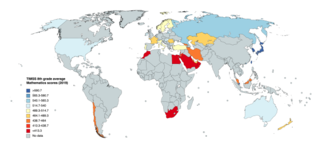
The United States does not have a national or federal educational system. Although there are more than fifty independent systems of education, there are a number of similarities between them. Education is provided in public and private schools and by individuals through homeschooling. Educational standards are set at the state or territory level by the supervising organization, usually a board of regents, state department of education, state colleges, or a combination of systems. The bulk of the $1.3 trillion in funding comes from state and local governments, with federal funding accounting for about $260 billion in 2021 compared to around $200 billion in past years.
Achievement gaps in the United States are observed, persistent disparities in measures of educational performance among subgroups of U.S. students, especially groups defined by socioeconomic status (SES), race/ethnicity and gender. The achievement gap can be observed through a variety of measures, including standardized test scores, grade point average, dropout rates, college enrollment, and college completion rates. The gap in achievement between lower income students and higher income students exists in all nations and it has been studied extensively in the U.S. and other countries, including the U.K. Various other gaps between groups exist around the globe as well.

The Programme for International Student Assessment (PISA) is a worldwide study by the Organisation for Economic Co-operation and Development (OECD) in member and non-member nations intended to evaluate educational systems by measuring 15-year-old school pupils' scholastic performance on mathematics, science, and reading. It was first performed in 2000 and then repeated every three years. Its aim is to provide comparable data with a view to enabling countries to improve their education policies and outcomes. It measures problem solving and cognition.

The National Assessment of Educational Progress (NAEP) is the largest continuing and nationally representative assessment of what U.S. students know and can do in various subjects. NAEP is a congressionally mandated project administered by the National Center for Education Statistics (NCES), within the Institute of Education Sciences (IES) of the United States Department of Education. The first national administration of NAEP occurred in 1969. The National Assessment Governing Board (NAGB) is an independent, bipartisan board that sets policy for NAEP and is responsible for developing the framework and test specifications.The National Assessment Governing Board, whose members are appointed by the U.S. Secretary of Education, includes governors, state legislators, local and state school officials, educators, business representatives, and members of the general public. Congress created the 26-member Governing Board in 1988.
The National Longitudinal Surveys (NLS) are a set of surveys sponsored by the Bureau of Labor Statistics (BLS) of the U.S. Department of Labor. These surveys have gathered information at multiple points in time on the labor market experiences and other significant life events of several groups of men and women. Each of the NLS samples consists of several thousand individuals, many of whom have been surveyed over several decades.
Dropping out refers to leaving high school, college, university or another group for practical reasons, necessities, inability, apathy, or disillusionment with the system from which the individual in question leaves.

The International Association for the Evaluation of Educational Achievement (IEA)'s Trends in International Mathematics and Science Study (TIMSS) is a series of international assessments of the mathematics and science knowledge of students around the world. The participating students come from a diverse set of educational systems in terms of economic development, geographical location, and population size. In each of the participating educational systems, a minimum of 4,000 to 5,000 students is evaluated. Contextual data about the conditions in which participating students learn mathematics and science are collected from the students and their teachers, their principals, and their parents via questionnaires.

The educational attainment of the U.S. population refers to the highest level of education completed. The educational attainment of the U.S. population is similar to that of many other industrialized countries with the vast majority of the population having completed secondary education and a rising number of college graduates that outnumber high school dropouts. As a whole, the population of the United States is spending more years in formal educational programs. As with income, levels differ by race, age, household configuration, and geography.
The Integrated Postsecondary Education Data System (IPEDS) is a system of interrelated surveys conducted annually by the National Center for Education Statistics (NCES), a part of the Institute for Education Sciences within the United States Department of Education. IPEDS consists of twelve interrelated survey components that are collected over three collection periods each year as described in the Data Collection and Dissemination Cycle. The completion of all IPEDS surveys is mandatory for all institutions that participate in, or are applicants for participation in, any federal financial assistance program authorized by Title IV of the Higher Education Act of 1965, as amended.

The most recent comprehensive data on adult literacy in the United States come from the Program for the International Assessment of Adult Competencies (PIAAC) study conducted in stages from 2012 to 2017 by the National Center for Education Statistics (NCES). English literacy test results from 2014 suggest that 21% of U.S. adults ages 16 to 65 score at or below PIAAC literacy level 1, meaning they have difficulty "[completing] tasks that require comparing and contrasting information, paraphrasing, or making low-level inferences." Included in that 21% is the 4.2% of respondents who were unable to be assessed due to language barriers, cognitive disability, or physical disability. A 2020 study by the Gallup analysis company funded by the Barbara Bush Foundation for Family Literacy estimated that getting all U.S. adults to at least PIAAC literacy level 3 proficiency would raise American's incomes by $2.2 trillion.
Statistics education is the practice of teaching and learning of statistics, along with the associated scholarly research.
The racial achievement gap in the United States refers to disparities in educational achievement between differing ethnic/racial groups. It manifests itself in a variety of ways: African-American and Hispanic students are more likely to earn lower grades, score lower on standardized tests, drop out of high school, and they are less likely to enter and complete college than whites, while whites score lower than Asian Americans.

High School and Beyond (HS&B) is a longitudinal study of a nationally representative sample of people who were high school sophomores and seniors in 1980. The study was originally funded by the United States Department of Education’s National Center for Education Statistics (NCES) as a part of their Secondary Longitudinal Studies Program. NORC at the University of Chicago, then known as the National Opinion Research Center, developed the sample design and performed the data collection for the study. The study surveyed students from over 1,000 public and private high schools on their cognitive and non-cognitive skills, high school experiences, work experiences, and future plans. Baseline surveys were administered in 1980, with follow-up surveys in 1982, 1984, 1986, 1992 (sophomores), 2014 (sophomores), and 2015 (seniors).
The Data Quality Campaign (DQC) is a nonpartisan, nonprofit advocacy organization launched in the United States in 2005 to improve the quality, accessibility and use of data in education.
First-generation college students in the United States are college students whose parents did not complete a baccalaureate degree. Although research has revealed that completion of a baccalaureate degree is significant in terms of upward socioeconomic mobility in the United States, a considerable body of research indicates that these students face significant systemic barriers to postsecondary education access, academic success once enrolled, and degree completion. Many of these obstacles result from systemic racial, cultural, social, and economic inequities.
Higher education in the United States is an optional stage of formal learning following secondary education. Higher education, also referred to as post-secondary education, third-stage, third-level, or tertiary education occurs most commonly at one of the 3,899 Title IV degree-granting institutions in the country. These may be public universities, private universities, liberal arts colleges, community colleges, or for-profit colleges. Learning environments vary greatly depending on not only the type of institution, but also the different goals implemented by the relevant county and state.
Sarah E. Turner is an American professor of economics and education and Souder Family Endowed Chair at the University of Virginia. She also holds appointments in the university's Department of Economics, the Batten School of Leadership and Public Policy, and the School of Education and Human Development. She is a faculty research associate at the National Bureau of Economic Research and a research affiliate at the Population Studies Center at the University of Michigan.

The National Postsecondary Student Aid Study (NPSAS) is a study conducted every four years by the National Center for Education Statistics, a division of the Institute of Education Sciences in the U.S. Department of Education. This study captures data regarding how students pay for postsecondary education, with special attention to how families fund higher education. The NPSAS, which has been conducted periodically since 1987, has a complex design, utilizing sampling and weighting to achieve a sample that represents college students nationwide.
The National Longitudinal Study of the High School Class of 1972 (NLS-72) was a comprehensive study conducted to track the educational, vocational, and personal development of high school seniors who graduated in 1972.







